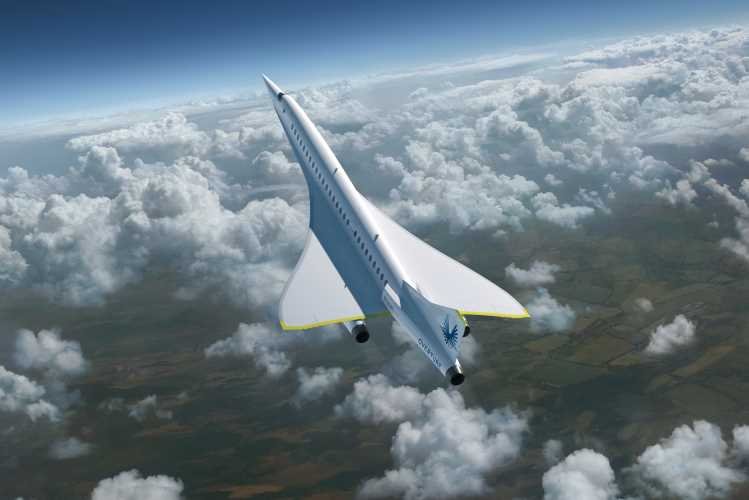Boom Supersonic is quietly working to reintroduce supersonic commercial travel. The Denver-based startup’s ultimate goal is ambitious: providing four-hour flights, to any location in the world, for $100. But first, Boom will need to flight test their first supersonic commercial jet, the first such jet since the Concorde.
Background: Supersonic Commercial Flights
For 27 years, commercial travelers enjoyed a supersonic flight option. Introduced in 1976, the Concorde seemed to set a new standard for commercial travel—offering Mach 2.04 speed, the Concorde shuttled passengers across the Atlantic in half the time of subsonic airliners. Yet, the Concorde was plagued with operational problems.
For one, the turbojet engines caused a sonic boom that was too loud for travel over population centers, so the Concorde was restricted to overseas routes. Also, to attain and maintain supersonic speed, the Concorde consumed 47 pounds of fuel per mile flown. For each transatlantic journey, the Concorde consumed nearly 7,000 gallons of fuel. And the narrow fuselage, which limited drag, also limited passenger capacity. Concorde flights struggled to turn a profit between the high fuel consumption and the limited number of passengers aboard the aircraft. Ticket prices rose to about $20,000 in today’s money for a round-trip. The Concorde was retired from service in 2003—just three years after an Air France Concorde crashed into a hotel on takeoff, killing 113. The commercial aviation sector has not offered a supersonic option since. Boom Supersonic hopes to change that.
Founded in 2014, Boom may be the leading candidate to reintroduce supersonic commercial travel. Last October, Boom rolled out their XB-1 prototype—a one-third sized design of the company’s proposed Overture supersonic transporter. The XB-1 is scheduled to begin flight testing in 2021. The Overture, and supersonic commercial flights, could be available by 2030. Of course, merely offering supersonic flights has been done before. Can Boom actually pull off four hour, $100 supersonic flights?


Analysis: Can Supersonic Commercial Flights Come Back?
Modern technology does not support aviation travel at speeds sufficient to span any two points on the globe in just four hours. Speed like that creates vicious amounts of heat, capable of melting modern engines. To accommodate traveling at such speeds, material science will need to advance.
Professor Sean O’Keefe of Syracuse University, formerly an Airbus chairman and Secretary of the US Navy, believes “it’s going to require two or three generations of technology, development, and breakthrough—which equates to about 20 years.”
Boom will also need to solve the fiscal and environmental problems that plagued Concorde.
Commercial aviation produces a large carbon footprint, which cuts into profits and generates more and more pushback from an increasingly eco-conscious public. Boom hopes to achieve higher sustainability (and higher public approval) with more efficient jet fuel and investing in carbon offsets. “What you’re basically doing is sucking carbon out of the atmosphere, liquefying it into the jet fuel, then you put that in the airplane,” Boom CEO Blake Scholl says in an interview with CNN, “so when it goes out the back of the airplane, you’re just moving carbon around in a circle.”
Outlook: The Future Of Commercial Air Travel
Despite the inherent challenges of developing affordable supersonic flight, Boom Supersonic is receiving high interest in their product. American Express Ventures invested in Boom this April. The US Air Force has invested, too, hoping that the upcoming Overture jet can serve as the new Air Force One one day. Competitors are working to keep up, too. Aerion Corporation and Spike Aerospace are currently working on their own supersonic commercial jets.
Supersonic commercial travel seems poised to return within the next decade or so. And if Boom can manage to create a jet that operates supersonically and affordably, the technology could eventually become commonplace. Travel times would be reduced. The world would shrink. “It changes where we can vacation, changes where we can do business, changes who you can fall in love with or who you can be close to,” Sholl says.
Follow Harrison Kass on Twitter: @harrison_kass
Don’t forget to follow us on Twitter, Facebook, and Instagram, to weigh in and share your thoughts. You can also get all the latest news and exciting feature content from The Debrief on Flipboard, and Pinterest. And subscribe to The Debrief YouTube Channel to check out all of The Debrief’s exciting original shows: DEBRIEFED: Digging Deeper with Cristina Gomez –Rebelliously Curious with Chrissy Newton

